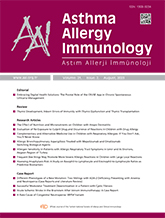


Objective: Complementary and alternative medicine (CAM) is widely used in children with respiratory allergies. The purpose of this study was to evaluate the use of CAM practices among children with asthma and allergic rhinitis (AR) and to determine the risk factors associated with CAM use.
Materials and Methods: A questionnaire, which consisted of 3 parts with 31 structured items, including demographic variables, the asthma- and/or AR-related characteristics, and CAM modalities was administered to the parents of 210 children with asthma and/or AR. The relationship between asthma control and CAM usage was evaluated by Asthma Control Tests (ACT) and the Pediatric Asthma Quality of Life Questionnaires (PAQLQ).
Results: Of the children, 79.1% had used at least one type of CAM within the last 6 months. Honey products, ginger, carob and mint with lemon were the most preferred forms of CAM. Presence of a family history of atopic diseases, maternal and paternal ages, and emergency department visits in the last year were significantly associated with CAM use (p=0.002, p=0.013, p=0.047, and p=0.001, respectively). The main reasons for CAM usage were frequent upper respiratory tract infections, long-term treatment of asthma and/or AR, and recurrent episodes of asthma exacerbations. Only 34.8% of the parents informed their physicians about their children`s CAM use.
Conclusion: The prevalence of CAM use was prevalent among children with asthma and/or AR. Healthcare professionals should be aware of the tendency for the use of CAM in children with respiratory allergies and should enquire the CAM history during the followup visits.